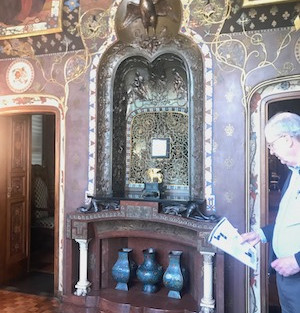The Poldi Pezzoli Museum
- Amy Unfried
- Apr 30, 2019
- 3 min read
Sunday night we had dinner with friends who are semi-relatives -- the sister and brother-in-law of Alessandro, who visited us in Siena. We had a lovely time with them at a very interesting fish-and-vegetarian restaurant, and received much useful information about what to do in Torino, our next stop after Milan, as well as how to spend Monday, a day when a great many cultural institutions (and also restaurants) are closed. Fortunately Maria Teresa knew that the Poldi Pezzoli museum is closed on Tuesdays (she having once tried to visit it on a Tuesday), and thus is open on Mondays, and that is where we went on Monday morning.

It is a "house museum," the actual house in which a wealthy individual lived and brought the objects he collected in his travels. Gian Giacomo Poldi Pezzoli (here seen in a portrait at about age 8) was the collector this time, and his museum grew in the same general way as three other house museums we have recently enjoyed in Paris, the Jacquemart-André, the Marmotton Monet and the Musée Cernusci, as well as the Frick Museum in New York and the Barnes Museum (when it was in Merion, in Dr. Barnes's real house, rather than Philadelphia).

The museum's logo is this lovely portrait of a young woman by Pollaiolo (ca. 1475) as its logo, and it is one of the first things one sees in the "Golden Room," a large light room where the dozen or more paintings of which they are most proud are concentrated.

There are also this appealing Botticelli "Madonna with a Book," in which all the figures have the languidly drooping eyelids that I have noticed a lot in Botticelli work during this trip.

"The Black Knight" by Giovanni Battista Moroni 1567 puts me in mind of some of Velasquez' portraits of black-clad gentlemen of sixty or so years later.

One of the things I liked best was this polychromed, gilded wood carving in low relief depicting "The Marriage of the Virgin"(ca. 1520) by Giovan Angelo Maino, whom the wall text calls "the most refined of the Lombard Renaissance wood carvers." The faces and costumes are wonderful.


Later in the progress through the very many rooms is the Perugino Room, where this Perugino "Madonna and Child" is the main attraction among many lesser names. The museum's impressively large collection contains many paintings from the various Italian schools of the fifteenth through seventeenth centuries, but there are many other areas of collecting, such as Flemish and Dutch paintings, furniture, porcelain and jewelry.

I came upon another St. Benedict painting by Nicolò di Pietri from 1415-20, which is another part of the same polyptych some of whose other parts were in the Uffizi, that I mentioned earlier. This one shows "St. Benedict, Tempted in the Wilderness Near Subiaco." The wall text says that he was "tormented by the devil in the guise of a blackbird (! -- sic), afflicting him with strong erotic temptations. To overcome desire, the saint stripped himself naked and rolled in a thicket of briars and nettles." That seems like a very practical and efficaceous solution to his problem, though not really miraculous. It does attest to his strong drive to remain holy under difficult circumstances. A blackbird, eh? Those sexy birds!

I liked this bronze bust of Bishop Ulpiano Volpi, by Alessandro Algardi (1640). For a long time it was attributed to Bernini, who influenced his work.
The museum houses a large collection of clocks of unusual styles and shapes, decorative watches, imaginatively designed watch-winding keys, etc. Most of them were collected by Poldi Pezzoli himself, but in 1973 his collection was added to by the donation of 129 clocks from Milanese entrepreneur Bruno Falck, and as a result the museum has what many consider the most important collection of timepieces in Italy.
The house, a 17th century palace which had been bought by one of Poldi Pezzoli's ancestors in the late 18th century, had been restructured and redecorated between 1851 and 1853 by the architect Giuseppe Balzaretto so that each room displayed the group of artworks in it in the best possible way. During the Allied bombing of Milan in 1943, the house was seriously damaged. The art treasures in it had been stored safely, but only one room remained sufficiently undamaged so that following several years of restoration it could again be shown more or less as it was. This is the Sala Dantesca, which pays homage to Dante. Its splendid elaborateness hints at how the whole house must have looked.









Comments